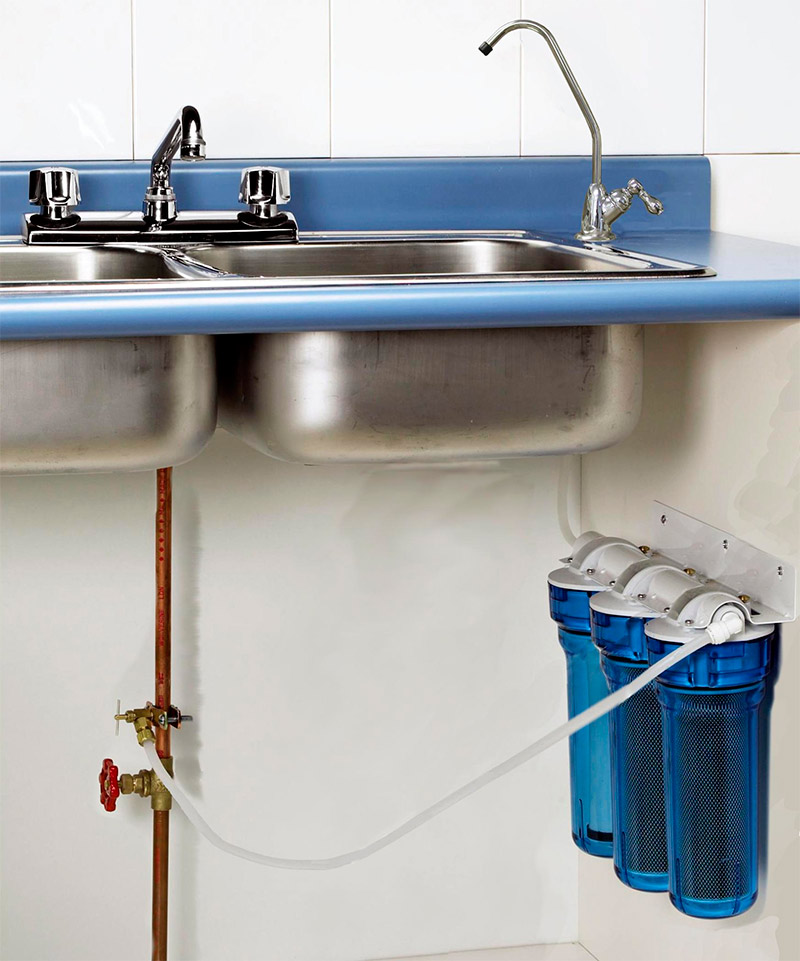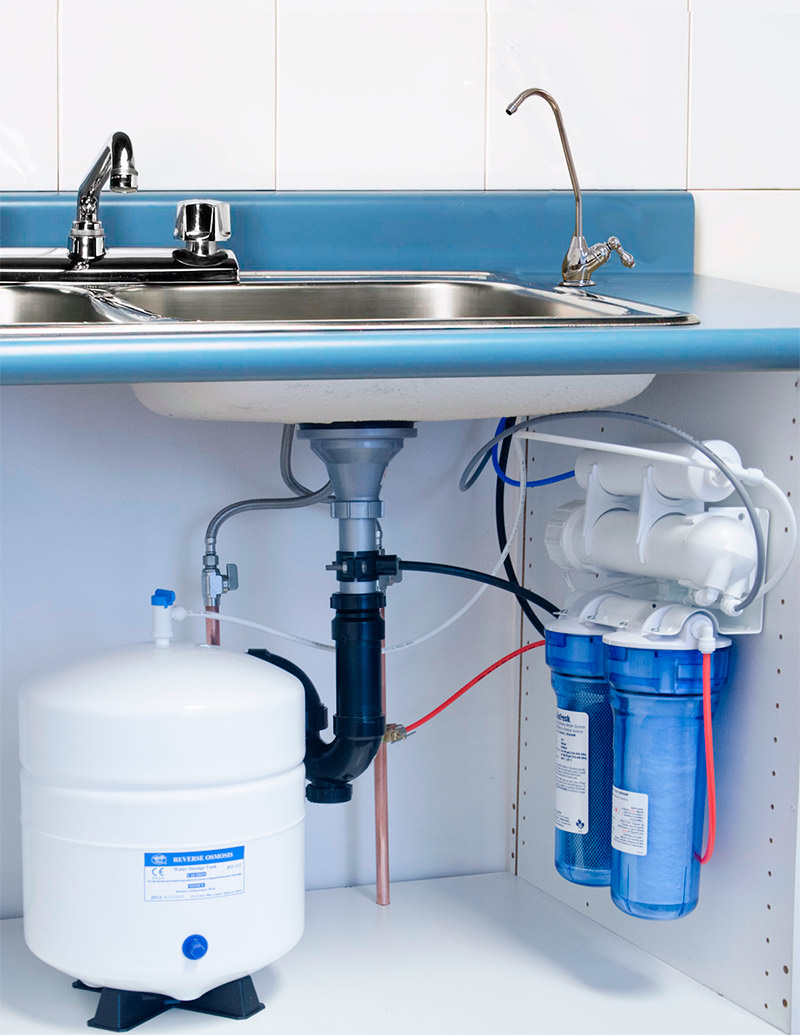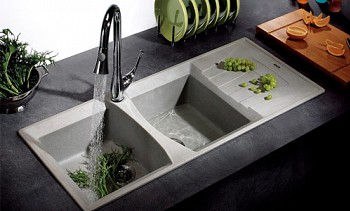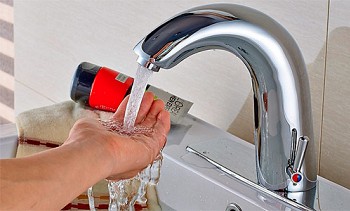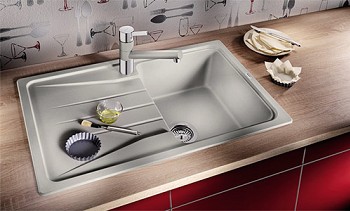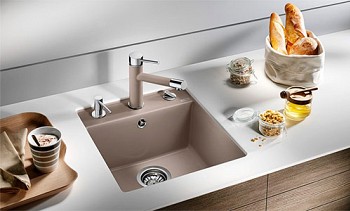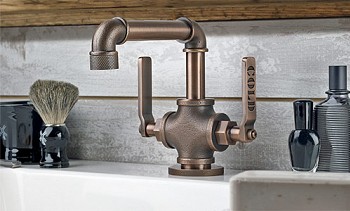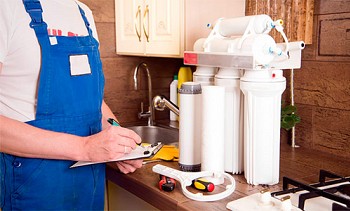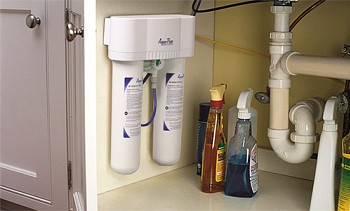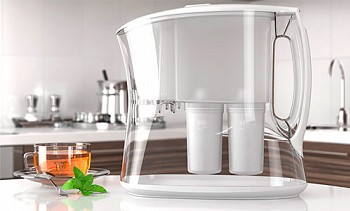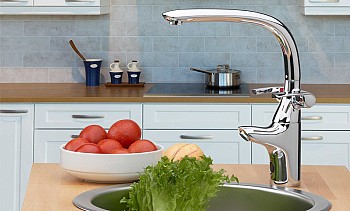Tap water does not differ in transparency, pleasant taste and purity. Often it can not be drunk raw, tea and coffee from it are not so aromatic and rich. Therefore, many today are considering how to choose a water filter for washing. Indeed, just such an option of water purification, as experience has shown, turned out to be the most convenient and practical.
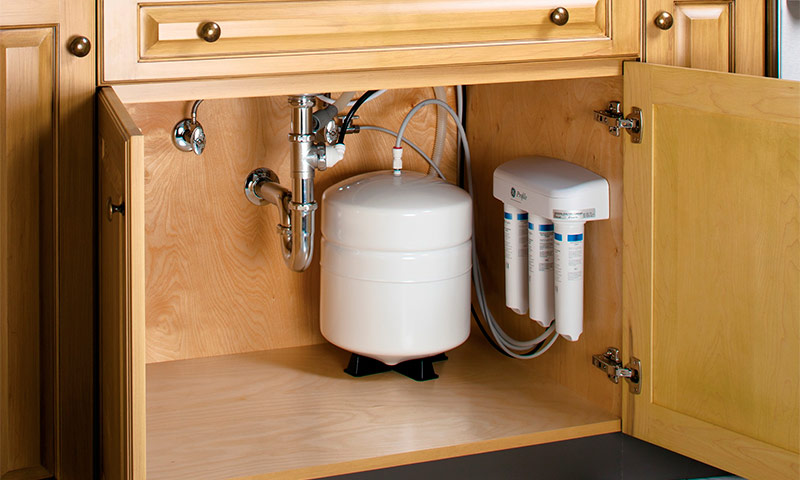
Content:
Features, device and varieties of water filters for washing
It would be a mistake to assume that these devices suggest some specific way of purifying water. The phrase “under the sink” only means that they are installed there - under the kitchen sink. Pipes suitable for the filter are connected by tapping with water pipes for cold water supply. And upstairs a separate faucet is displayed, from which it will be possible to collect purified water.
If there is too little space under the sink, then a wall-mounted installation of the filter system is possible - this is also practiced. Existence of the crane gives comfort of use. Framed the kettle - and pour as much as needed. Or you can immediately pour in a cup of water to drink.
Varieties of filters for washing
As for the design features of filters with placement under the sink, they can be performed in two versions - reverse osmosis systems and flow-through sorption filters.
1. Flow-through sorption filters. These are the most simple and inexpensive devices. they are several (from two to four) containers, connected in series with each other, inside of which are filter cartridges. Such filters are connected to the water supply system using flexible eyeliner. It is most convenient and practical to do this under the sink. Well, a small faucet for clean water is placed on top.
Flasks with filter elements can be from two to four. Each flask contains a cartridge with a specific filler. Some of them carry out mechanical, others sorption cleaning. Some filters are also equipped with UV disinfection systems. Tap water, passing through all these flasks, is sequentially purified, at the beginning of mechanical impurities, and then from smaller inclusions. As a result, the smell of bleach and rust, metal impurities and pesticides, dirt with sand, oil products leave the water. As well as pathogenic bacteria that, when neutralized, are no longer able to cause harm.
Flowing systems, in addition to city apartments, are also used in cottages, cleaning insufficiently well water or water collected from a well. Delicious, like from a spring, water acquires transparency and purity. You can cook or wash your food.
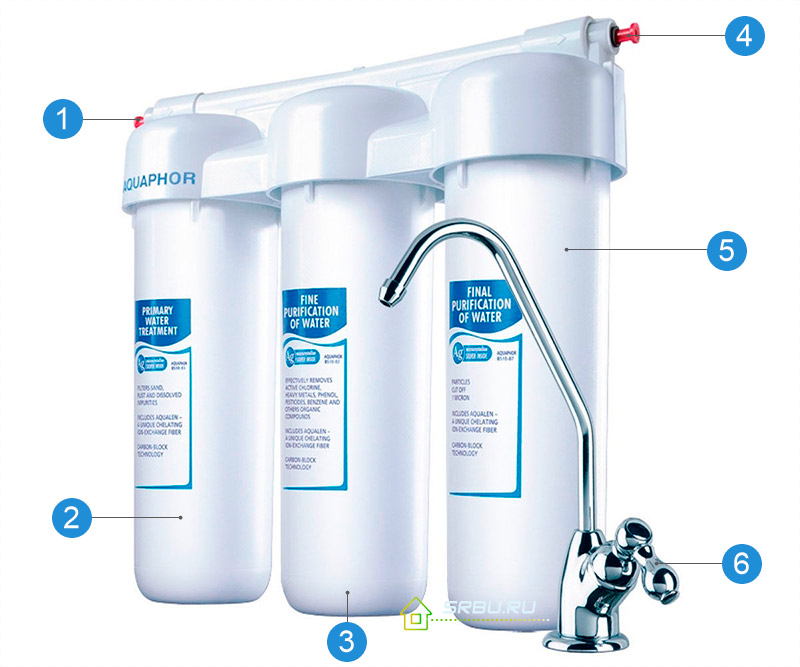
The device of the main components of the flow filter "under the sink": 1. Node for connecting water; 2. The filter of preliminary sorption or mechanical cleaning; 3. Filter of deep sorption cleaning; 4. Node for connecting a crane; 5. Filter for final cleaning and conditioning; 6. The crane. * (The set of filtering modules will depend on the specific filter model).
2. Reverse osmosis systems. And yet, deciding which water filter to choose for washing, most consumers stop at this option. In one of the modules of this filter there is a sensitive membrane, capable of passing only water molecules further. And all impurities contained in the liquid are safely held on its surface, and then washed off.
At first glance, visual differences with a flow-through sorption filter are not visible at all. The same few connected tanks. Yes, and this filter is mounted in the same way - it is connected under the sink to water pipes. However, there is a fundamental difference. In addition to flasks with cartridges of sorbents, an osmotic membrane is located in one flask. In addition to this, these cleaning systems contain a tank designed to create a supply of clean water. This is because the rate of passage of water through the membrane is not as high as the rate of passage through the sorption filter.
Pre-filters purify water mechanically and with a carbon filler. The filter, standing after the membrane, mineralizes and deodorizes water.
Perhaps, around the world there is no system more popular than reverse osmosis. A membrane with tiny holes holds all the harmful substances, which then simply go into waste water.
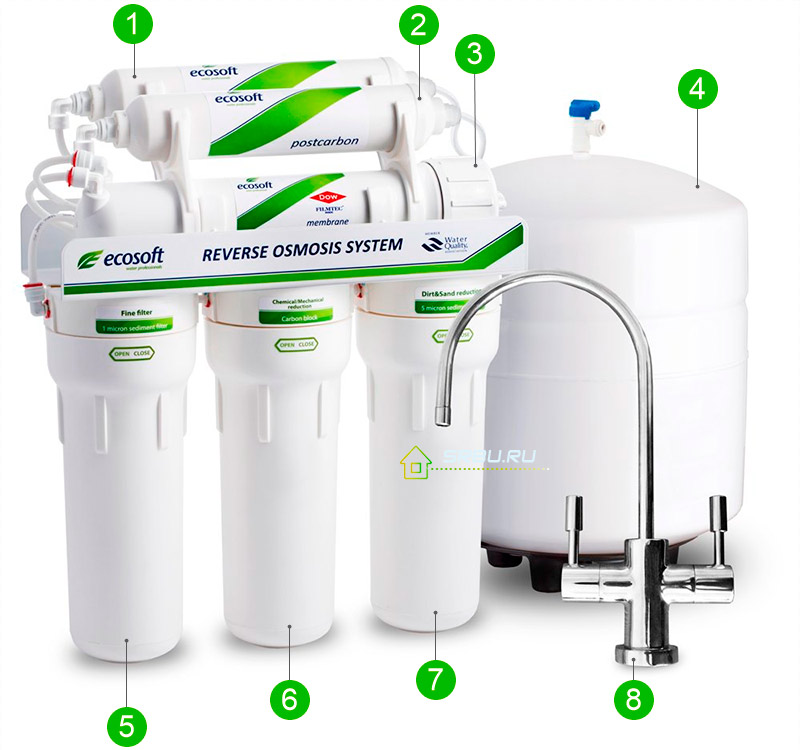
The device of the main components of the reverse osmosis system: 1. Filter-mineralizer; 2. Post filter for conditioning; 3. Module with reverse osmotic membrane; 4. Storage capacity; 5. Filter mechanical cleaning; 6. Filter for sorption purification; 7. Sorption filter for final cleaning; 8. The crane. * (The set of filtering modules will depend on the specific filter model).
Let us dwell on the principle of operation of these filters in more detail:
#1 part. The three initial stages are called the preliminary preparation unit. They include three vertical vessels with prefilter cartridges. This is a necessary operation before membrane cleaning - you need to remove dirt, sand, rust so that the sensitive membrane does not clog or tear. And at the same time the smell of chlorine leaves the water. For this, mechanical filters and sorption carbon filters are used. In some models, an ultraviolet module is also used here.

# 2 part. Next is the fourth step. This is where the “heart” of the system — the membrane — is placed. It is made of thin polymer and rolled up in the form of a roll. Her pore sizes are extremely small and range from 1 to 15 angstroms. There are also nano-filtration systems. Their pores in the membrane are larger - from 10 to 70 angstroms (because of this, part of the impurities passes further).

# 3 part. The storage tank is equipped with a special membrane that responds to filling. As soon as the tank is full, the water supply will stop. The volume of this tank is on average about 10 liters. This is enough for a family of three or four to be provided with water.

# 4 part. The last - fifth stage is equipped with a carbon-filled post-filter. It is needed to completely get rid of the unpleasant taste that may remain.

# 5 part. And so that you can conveniently pour clean water, the installation is crowned by a crane. It is placed on the sink and attached to the storage tank.

That, in fact, is all. That is how they produce on an industrial scale quality water, sold in stores in large and small bottles. And if you put a filter at home, you can enjoy clean water without leaving your own kitchen.
Types of cartridges used for filtering

Sorption type cartridges usually have a carbon filler inside. Their purpose is to remove odors, chlorine, phenol.

Ion exchange cartridges contain a special resin that softens too hard water.

Polypropylene cartridges are used for mechanical purification of water (from pieces of dirt, grains of sand, rust).

Cartridges of the combined type allow you to get rid of several impurities and harmful substances at once.
The choice of filter for washing, depending on problems with water
In order to understand how to choose a filter for cleaning water for washing, you need to know what contaminants are present in the water. To do this, you need to do its analysis by typing in a clean (required) bottle with a capacity of one and a half liters of water.And then go to the sanitary epidemiological station or a testing center. In the first case, it will be cheaper, but longer, in the second - quickly, but more expensive.
The examination is carried out very thoroughly, for as many as thirty points. However, all of them can be divided into several general categories:
- the presence of radioactive substances (the most dangerous thing that can be);
- pH is too high or too low (pH);
- excess salts;
- increased rigidity and large solids;
- excess iron content;
- the presence of nitrites or nitrates (as well as similar compounds);
- poor taste, smell, color, increased turbidity;
- organic contamination (bacteria and viruses).
The norms of impurity content are determined by SanPiN 2.1.4.559–96. After collecting all the necessary information, you can proceed to the final selection of the filter for washing. The main thing in this case is to determine the number and type of cartridges (for which analysis was carried out).
Attention! Only after collecting all the information about water problems, you can understand how many and which cartridges should be in the filter for washing.
If the water is too hard
To determine excessive rigidity, sometimes expertise is not necessary. With the naked eye, this is noticeable: scum quickly appears in the teapot, limescale on the sink and toilet bowl, and ugly stains on washed dishes.
In this case, you should not install a flow filter, as it will be expensive to operate and will not give the desired effect. Systems of this type are of course equipped with softening filters, but the thing is that the cartridges softening the water will cease to cope with the duties too quickly. They will have to be changed or restored using saline. However, harmful impurities will still be successfully filtered. But this will not protect your kettle from scale. Very often, negative reviews can be heard about this, but in fact, it is not the filtration system that is to blame, but the one who decided to use it to clean hard water.
But the reverse osmosis system is able to cope with water of any hardness, turning it into soft and tasty. Indeed, it is this quality that makes coffee and tea unique, and also improves the taste of all dishes. And the reverse osmosis system removes water from any bacteria, nitrates, antibiotics and eggs of various parasites (for example, giardia) - cysts.
Only a reverse osmosis system can effectively deal with hard water.
If microorganisms are present in the water
If an allergic person or a person with a weak digestive system lives in the house, then immunologists strongly recommend antibacterial treatment of water. It is also necessary for the elderly, small children, those who have recently been ill and have weakened immunity. And then we select the filter for water for washing, taking into account these nuances.
In this case, a reverse osmosis filter will help again. Or you can advise a flow-through system equipped with a special hollow fiber filter. It consists of porous (with pores of not more than 0.1 microns) tubes, thin and perfectly coping with viruses, bacteria, cysts. This is how blood plasma is cleaned in laboratories.
However, mechanical cleaning cannot remove very small bacteria. Therefore, it is necessary to provide that an ultraviolet disinfector is present in the filter. The power and throughput of different models of such disinfectors can be different. The more power and the longer the device works, the better the cleaning. According to the standard, 16 kJ / cm is enough power2.
If chemical contamination is present in the water
To get rid of iron, chlorine and other chemical impurities, a flow-type system is enough (but the water should not be too hard). The types of filters for such systems are selected depending on water problems.
These can be complex filters and carbon filters that trap rust particles, remove turbidity and unpleasant odors.If necessary, care should be taken to have highly specialized cartridges in the system. These can be cartridges to remove iron or soften water.
The main criteria for choosing filters for washing
Flow filters
Let's start with simpler devices and tell you how to choose flow filters for water for washing.
1. The number of cleaning steps. Most models have three or four. In the first case, preliminary mechanical cleaning takes place in one module, and then complete post-treatment together with softening. At the finish is sorption purification. If there are four modules, then the water is also disinfected.
2. Resource cartridge module. It is important. After all, it happens from 4 to 12 thousand liters (a difference of three times). When the resource has expired, a filter replacement is required. Once a year, at least.
3. How many people will use purified water. For a small family, for example, a small amount is enough. And if the system is installed in an office, kindergarten or for a large (more than five members) family, then you need a filter designed for increased water consumption and having a longer resource for replaceable modules. Pay attention to this when choosing the appropriate model.
4. Service cost. It happens that with an inexpensive device, replaceable cartridges are so expensive that almost half of its cost is. Before you buy a particular model, take an interest in the price of consumables, as well as their availability on sale.
5. System Options. Check that there is an installation kit. It includes, in addition to a tap, a block of collectors and adapters, tubes for connecting modules and connecting to a water supply. Detailed assembly instructions are usually included. To the home master it is quite “tough”.
Reverse osmosis systems
1. Water pressure in the water supply. To install such a system, you must have sufficient pressure in the water supply system. Not lower than 3 - 3.5 atmospheres. And if suddenly it does not reach the required three atmospheres, then you will need to purchase a special pump, which will raise the pressure to the required limit. Some models come with an already built-in pump.
2. The dimensions of the device and the dimensions of the space under the sink. Check if the dimensions of the filter allow it to fit under the sink (or on the wall). Do not forget that this filter has a storage tank and it may happen that the allocated area is not enough.
3. Check the manufacturing quality of the membrane container. This is the weakest point. Optimally, if there is a cover on top, and it has two o-rings. And then, even with pressure differences, the bulb will not crack.
4. Valve design. If it is made of metal, and its gasket is ceramic, then this is good. Plastic valves break quickly.
5. The volume of the storage capacity. Select the volume of storage capacity according to your needs. A five-liter tank is enough for one person, if there are three or four people in a family, then you need to focus on ten or twelve liters. The material of the container is also important. Metal is stronger, but it corrodes, unlike less durable plastic.
6. Pay attention to the price of consumables and maintenance. Be sure to look into the cost (and availability) of replaceable cartridges. To service then did not cost a pretty penny.
7. Pay attention to additional cleaning steps. Take a look at the extra steps to purify the water. For example, the presence of an ultraviolet module, a mineralizer, as well as a structurizer. They are not provided in all models, but depending on the problems with your water, some modules will be very useful.
Features of operation and maintenance of water filters
Distilled water: is it harmful?
Putting a reverse osmosis system, you need to be ready for the degree of water purification by 98 - 99 percent. In other words, we get almost distilled water, which scares some. Like, where can we get the necessary trace elements and salts for a person? They are all removed from the water.So there is such an opinion among some ordinary consumers.
However, medical specialists have successfully dispelled this myth. It is lucidly explaining that you cannot cover the daily need for minerals with water alone. And basically they come to us with a variety of food. For example, to get the right amount of calcium, you have to drink 10 liters of water per day - a bit too much. The same amount of calcium is found in - 12 grams of cheese or 75 grams of cottage cheese. Next, we give the data in the table.
| Element | How much per day, mg | Content in plain water, g / l | The volume of water to ensure the daily rate, l | The possibility of obtaining from water,% | Product containing this item | Product weight to ensure daily allowance, g |
|---|---|---|---|---|---|---|
| Calcium | 800 | 100 | 8 | 15 | Cottage cheese | 75 |
| Beans | 80 | |||||
| Hard cheese | 12 | |||||
| Magnesium | 500 | 50 | 10 | 12 | Watermelon | 27 |
| Buckwheat | 30 | |||||
| White bread | 68 | |||||
| Sodium | 2000 | 12 | 166 | 0,72 | Soft cheese | 0,6 |
| Pickle | 26 | |||||
| Q cabbage | 15 | |||||
| Black bread | 27 | |||||
| Potassium | 5000 | 200 | 25 | 4,8 | Tomatoes | 4,03 |
| The apples | 5 | |||||
| Potatoes | 1,18 | |||||
| Beans | 0,86 |
So, as you can see, ordinary water is not very suitable for supplying the body with minerals - not a single person can drink it so much (especially to get enough potassium). And there is nothing wrong with distilled water. You just need to eat right, eating a variety of foods: vegetables, fruits, dairy, legumes, and so on.
How often do I need to change cartridges
The cartridge will live, working properly, from three to six months. The frequency of replacement depends on several factors. In particular, how intensively the filter is used and on the quality of the water coming from the water supply. So, in the case of a large number of mechanical impurities, it is often necessary to replace a cartridge made of polypropylene. Which is just engaged in the mechanical purification of water.
The membrane in the reverse osmosis system will have to be replaced once every one and a half or two years. The minimum that she will serve is a year. And then each manufacturer has its own recommendations regarding the timing of membrane replacement. It should be noted that the usual membrane passes more than 185 liters of water in one day. These are solid volumes.
And finally, it’s worth remembering that for any type of filter installed under the kitchen sink, one thing is common. For them, it is important for everyone to replace the cartridges on time. After all, when the resource is exhausted, they not only turn out to be useless, but can also harm.

